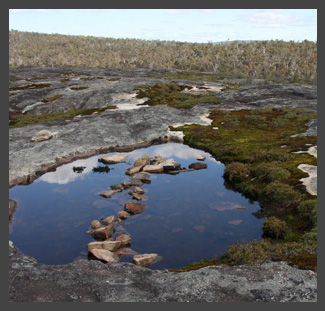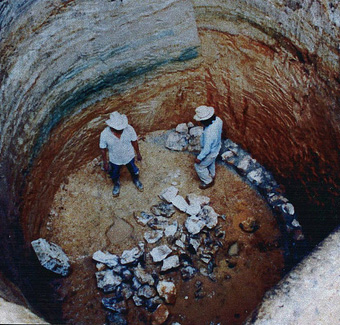Difference between revisions of "Drought resilience - Technical solutions"
From Akvopedia
| (21 intermediate revisions by the same user not shown) | |||
| Line 1: | Line 1: | ||
| − | __NOTOC__ | + | __NOTOC__ <small-title /> |
| + | Managing and adapting to drought can be done by using small-scale technical solutions to access, store, treat, distribute, and productively use water. These technologies help increase the availability of water, are suitable in drought prone areas, and show the best methods on how to make water systems more resilient to drought. | ||
| + | |||
The list below are technical measures to increase the [[Resilient WASH systems in drought-prone areas|resilience of WASH systems]]. | The list below are technical measures to increase the [[Resilient WASH systems in drought-prone areas|resilience of WASH systems]]. | ||
| − | ====Surface water: Managed Aquifer Recharge (MAR) ==== | + | |
| + | [[Image:infiltration ponds small.jpg|thumb|right|150px|[[Infiltration ponds]]]] | ||
| + | [[Image: bare rock catchment small.jpg|thumb|right|150px|[[Natural rock catchment and Open water reservoir]]]] | ||
| + | [[Image:rainwater harvesting small.jpg|thumb|right|150px|[[Rooftop rainwater harvesting]]]] | ||
| + | [[Image:HandDugWell.jpg|thumb|right|150px|[[Traditional hand-dug wells]]]] | ||
| + | |||
| + | ====Surface water: Managed Aquifer Recharge (MAR)==== | ||
* [[Infiltration_ponds|Infiltration ponds]] | * [[Infiltration_ponds|Infiltration ponds]] | ||
* [[Contour trenches|Contour trenches]] | * [[Contour trenches|Contour trenches]] | ||
| Line 10: | Line 18: | ||
* [[Drip Irrigation - Pepsi and Nica|Drip irrigation]] | * [[Drip Irrigation - Pepsi and Nica|Drip irrigation]] | ||
* [[Wells, shafts, and boreholes|Well shafts & boreholes]] | * [[Wells, shafts, and boreholes|Well shafts & boreholes]] | ||
| + | |||
====Surface water: ground catchment & storage==== | ====Surface water: ground catchment & storage==== | ||
| Line 16: | Line 25: | ||
*[[Natural ground catchment and Open water reservoir|Natural ground catchment and Open water reservoir]] | *[[Natural ground catchment and Open water reservoir|Natural ground catchment and Open water reservoir]] | ||
*[[Catchment and storage dams]] | *[[Catchment and storage dams]] | ||
| + | |||
====Surface water: other catchment & storage==== | ====Surface water: other catchment & storage==== | ||
| − | *[[ | + | *[[Rooftop rainwater harvesting]] |
*[[Dew collection and storage]] | *[[Dew collection and storage]] | ||
*[[Fog collection and storage]] | *[[Fog collection and storage]] | ||
====Shallow groundwater==== | ====Shallow groundwater==== | ||
| − | *[[ | + | *[[Traditional hand-dug wells]] |
*[[Riverbed hand-dug wells]] | *[[Riverbed hand-dug wells]] | ||
*[[Riverbed infiltration galleries]] | *[[Riverbed infiltration galleries]] | ||
| Line 34: | Line 44: | ||
====General tips==== | ====General tips==== | ||
*[[Concrete production and drought]] | *[[Concrete production and drought]] | ||
| + | * [[Desalination / Evaporation]] | ||
| + | *[http://www.bbc.co.uk/news/world-africa-18412127 In pictures: Niger's hunger-fighting trees.] A photographic explanation of how the moringa tree is drought-resistant and providing a consistent food supply. | ||
Latest revision as of 05:27, 20 December 2013
Managing and adapting to drought can be done by using small-scale technical solutions to access, store, treat, distribute, and productively use water. These technologies help increase the availability of water, are suitable in drought prone areas, and show the best methods on how to make water systems more resilient to drought.
The list below are technical measures to increase the resilience of WASH systems.
Surface water: Managed Aquifer Recharge (MAR)
- Infiltration ponds
- Contour trenches
- Bunds
- Gully plugs / check-dams
- Leaky dams
- Controlled flooding / irrigation
- Drip irrigation
- Well shafts & boreholes
Surface water: ground catchment & storage
- Natural rock catchment and Open water reservoir
- Natural or artificial ground catchment and Lined sub-surface tanks
- Natural ground catchment and Open water reservoir
- Catchment and storage dams
Surface water: other catchment & storage
Shallow groundwater
- Traditional hand-dug wells
- Riverbed hand-dug wells
- Riverbed infiltration galleries
- Infiltration wells
- Spring water sources
- Groundwater - Sand_dam
- Controlled flooding / Spreading basins
- Subsurface harvesting systems
General tips
- Concrete production and drought
- Desalination / Evaporation
- In pictures: Niger's hunger-fighting trees. A photographic explanation of how the moringa tree is drought-resistant and providing a consistent food supply.




